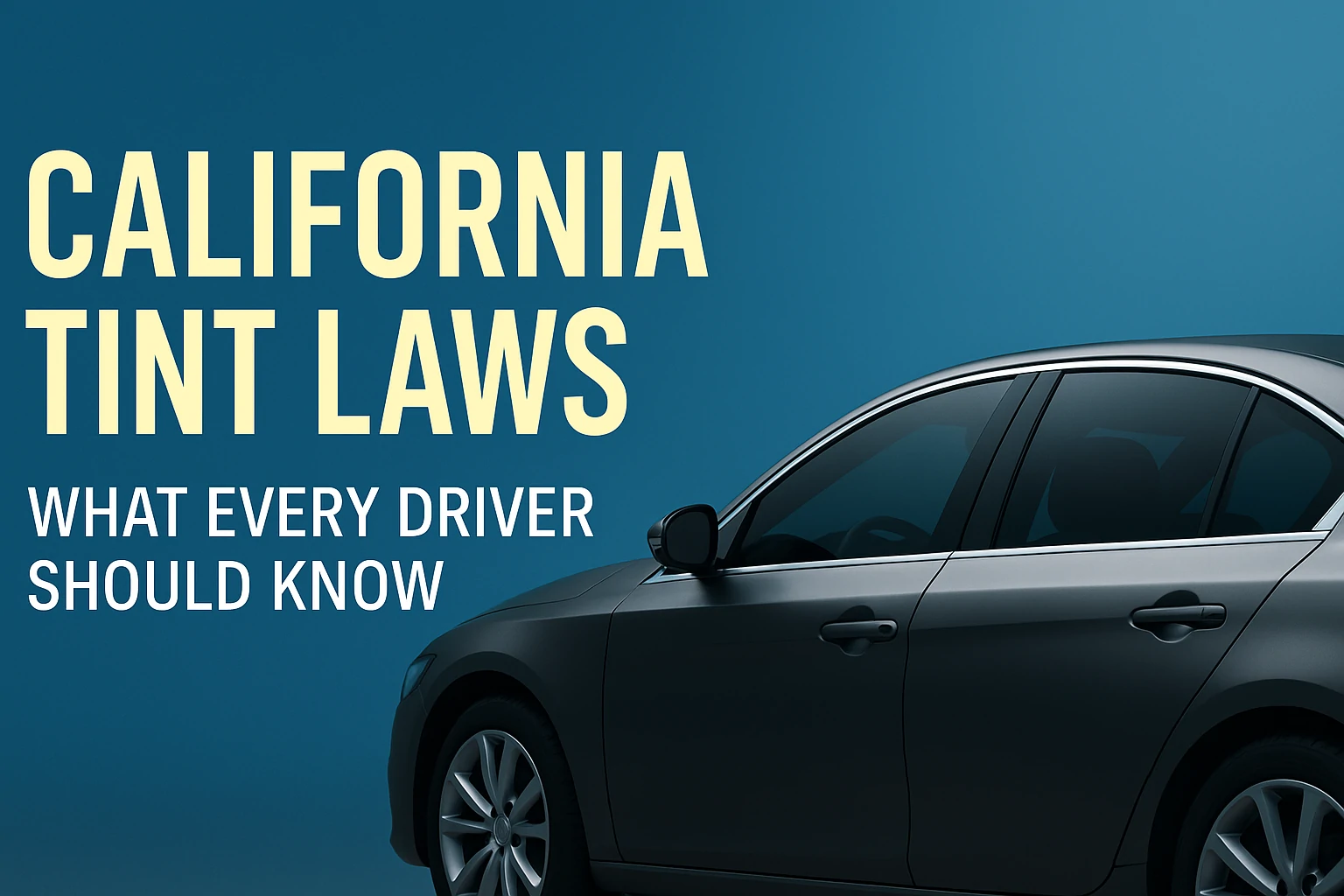Window tint can make your car look sharp. It can also help block sunlight, reduce glare, and give you more privacy. But not every tint is legal. California has rules that every driver must follow.
Many people do not know the exact laws about window tint in this state. Some rely on word of mouth or what friends say. Others trust the shop that installs the tint. That can lead to trouble. You may get stopped by police or fail your vehicle inspection if the tint is too dark or not placed correctly.
This article explains California’s window tint laws in clear terms. You will learn what is legal and what is not. You will also see the rules for front, back, and side windows. We will also talk about medical exceptions and the penalties for breaking these rules.
If you live in California and plan to add tint to your car windows, read this first. It may save you from a costly mistake or unwanted ticket.
What Is Window Tint?
Window tint is a thin film placed on glass. It helps block sunlight and keeps the inside of the car cooler. It also reduces glare and protects the interior from sun damage. Some drivers use tint for privacy or to improve the look of the car.
Not all tint blocks the same amount of light. Some films are clear, others are very dark. This is where the law comes in. Each state sets rules on how much light must pass through the glass.
In California, those rules are strict. The state checks how dark the tint is by measuring something called VLT, or Visible Light Transmission. This shows the percent of light that passes through the window. A lower number means a darker tint.
What Are the Legal Tint Limits in California?
California law sets different rules for different windows on your vehicle. Let’s go over each one.
Front Side Windows
The windows next to the driver and front passenger must let in at least 70% of light. This means they can only have a light tint. Dark tint on these windows is not allowed, no matter how good it looks or how hot the weather is.
Windshield
The windshield must stay mostly clear. You may add a strip of tint at the top, known as the sun visor strip. This strip cannot be more than 4 inches in height. The rest of the windshield must remain untinted unless you have a medical exemption.
Back Side Windows
Back seat side windows can have any level of tint. California law does not limit how dark these can be. You can use deep tint or even blackout film if you prefer. Just make sure you still have clear side mirrors.
Rear Window
You can tint the rear window to any darkness level. If you do, your car must have dual side mirrors. This helps the driver see the road clearly even if the back window is hard to see through.
Are Reflective or Colored Tints Allowed?
California also has rules about how the tint looks, not just how dark it is.
Reflective Tint
California does not allow tint that looks like a mirror. The film cannot reflect more light than clear glass. Chrome and shiny tint often break this rule. These styles may look sharp, but they are not legal.
Colored Tint
California does not allow red, blue, or amber window tint. These colors can cause confusion on the road. Some may look like police or emergency lights. To avoid trouble, use shades like gray, black, or smoke. These options keep your car legal and safe.
Medical Exemptions
Some drivers need dark tint due to a medical issue. California allows exceptions in these cases, but the driver must have the correct paperwork.
A doctor must write a letter that explains the need. This letter should include:
- A clear medical reason
- The date
- The doctor’s license number and signature
The law does not allow extra-dark front window tint even with an exemption. Instead, you may use clear, colorless film that blocks UV rays. You must keep a copy of the doctor’s note in the car at all times. You may show this to police during a traffic stop if asked.
Commercial and Multi-Purpose Vehicles
Rules may differ for SUVs, vans, and trucks. These vehicles often have more freedom when it comes to back window tint. The law treats them as multi-purpose vehicles, which may have darker tint in back even if front windows follow standard rules.
Still, all front windows and windshields must meet the same light standards as cars. No vehicle can ignore these rules, no matter its size or model.
What Happens If You Break the Tint Law?
The penalties for illegal tint in California can vary. Most times, you will not go to court, but you may face the following:
Fix-It Ticket
Police may give you a correctable citation, also known as a fix-it ticket. You must remove the tint or make it legal, then show proof to the police or DMV.
Fine
You may also pay a fine, usually around $25 for the first offense, and more if it happens again. The court may also add fees, making the total higher.
Insurance Issues
Too much tint may cause problems if you get into a crash. Some insurance companies may deny claims if your car does not follow state safety laws. It’s a risk not worth taking.
How to Stay Compliant
You can avoid problems by knowing the rules before you tint your car.
- Choose a trusted tint shop. A good shop knows the legal limits and will follow them.
- Ask for documentation. Keep a copy of the tint specs with your car records.
- Measure the VLT. Ask the shop or use a device to check the light level.
- Avoid DIY kits. These often go too dark and do not meet state law.
- Know your vehicle type. Multi-purpose vehicles have more flexibility in rear windows.
If you already have tinted windows, have them checked. A simple test can show if your tint meets California’s legal limits.
Recent Updates and Local Variations
California tint laws do not change often. Some cities may check tint more than others. Police in one area may give more tickets than police in the next town.
You can find updates on the California DMV or Highway Patrol websites. These sources share clear rules and any changes to the law.
Conclusion
California sets clear rules on window tint. These laws protect drivers and help keep roads safe. Front windows must allow most light through. Windshields must remain almost clear. Back windows have more freedom but must follow certain guidelines.
Reflective or colored tints are not allowed. Medical exemptions are limited and must include a valid doctor’s note. Vehicles that break the rules may get tickets, fines, or face problems with insurance.
If you plan to tint your windows, use a legal film and follow all limits. A good tint shop can guide you. Taking time to check the law now can save you time, money, and stress later.
Frequently Asked Questions
Q: Can I tint my whole windshield?
The law does not allow full windshield tint. Only the top 4 inches may have film. The rest must stay clear unless a medical note allows special protection.
Q: Is factory tint legal?
Tint applied at the factory meets legal standards. If you add extra film, it must still follow California tint limits.
Q: Do I need dual mirrors if I tint the rear window?
Cars with dark tint on the rear window must have two side mirrors. These mirrors must work and give a clear view behind you.
Q: What is the legal VLT for front windows?
The front side windows must let at least 70% of visible light through. Tint that blocks more light is not legal.
Q: Can I get pulled over just for tint?
Police can stop any car with tint that looks too dark or reflective. Officers may use a device to test it on the spot.




